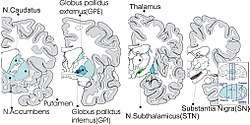Subthalamus
The subthalamus or prethalamus is a part of the diencephalon.[1] Its most prominent structure is the subthalamic nucleus. The subthalamus connects to the globus pallidus, a basal nucleus of the telencephalon.[2]
| Subthalamus | |
|---|---|
 Coronal slices of human brain showing the basal ganglia, subthalamic nucleus (STN) and substantia nigra (SN). STN is in subthalamus; SN is not. | |
| Identifiers | |
| MeSH | D020530 |
| NeuroNames | 434 |
| NeuroLex ID | birnlex_708 |
| TA | A14.1.08.201 A14.1.08.701 |
| FMA | 62010 |
| Anatomical terms of neuroanatomy | |
Structure
The subthalamus is located ventral to the thalamus, medial to the internal capsule and lateral to the hypothalamus. It is a region formed by several grey matter nuclei and their associated white matter structures, namely:[3]
- The subthalamic nucleus, whose neurons contain glutamate and have excitatory effects over neurons of globus pallidus and substantia nigra
- Zona incerta, located between fields of Forel H1 and H2. It is continuous with the thalamic reticular nucleus and receives input from the precentral cortex.
- Subthalamic fasciculus, formed by fibers that connect the globus pallidus with the subthalamic nucleus
- Fields of Forel
- Ansa lenticularis
During development the subthalamus is continuous with the hypothalamus, but is separated by white matter fibres mainly from the internal capsule. Caudally, the subthalamus or prethalamus is separated from the thalamus by the zona limitans intrathalamica.
Postnatally, the subthalamus lies beneath the thalamus, hence 'sub' (meaning below) 'thalamus'. It also lies dorsolateral to the hypothalamus.
Connections
The subthalamus develops efferent (output) connections to the striatum (caudate nucleus and putamen) in the telencephalon, to the dorsal thalamus (medial and lateral nuclear groups) in the diencephalon, and to the red nucleus and substantia nigra in the mesencephalon. It receives afferent (input) connections from the substantia nigra and striatum.
See also
References
- "subthalamus". Archived from the original on November 26, 2007.
- "Theme atlas of anatomy: head and neuroanathomy".
- Carpenter, M. (1991). Core Text of Neuroanatomy. Williams & Wilkins. ISBN 978-0683014570.
External links
| Wikimedia Commons has media related to Subthalamus. |